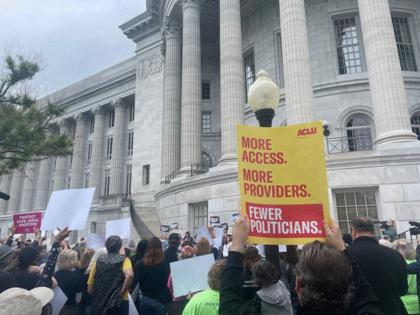Lisa Jarvis: Leaving abortion rights to the states isn't working
Published in Op Eds
When Missouri voters codified abortion rights in the state’s constitution last week, it was a bright spot in an otherwise dark week for reproductive freedom. The result promises to reconfigure the abortion access map in the U.S. at a critical time.
And while advocates for women’s health should celebrate the win, the uncertainty about what happens next in Missouri underscores a bitter truth: Without protection in the U.S. Constitution, reproductive rights in any state are precarious.
Such ballot initiatives are not allowed in most states with bans, so the U.S. abortion map today may be the map indefinitely. Access to abortion can be also undermined by actions at the federal level, or by state judges, attorneys general, or lawmakers. Missouri’s own Republican state lawmakers have vowed to keep fighting the people’s will.
Missouri is a microcosm of the limitations of our nationwide patchwork of abortion access. One of seven states in which the public voted last week to broaden or enshrine the right to abortion, Missouri’s referendum was widely considered the biggest victory. That’s because, out of those seven, Missouri had the most draconian ban — one with no exceptions. It was also the first such law to go into effect after the Supreme Court overturned Roe v. Wade in 2022.
What the vote means for abortion access in Missouri, however, is still to be determined. The vote in Missouri does not magically reopen clinics, or even automatically repeal the state’s ban. Rather, the referendum allowed the state’s two Planned Parenthood providers to file a lawsuit asking the courts to null the laws that now conflict with its constitution.
Planned Parenthood and the ACLU, which are representing the local providers in the case, hope the Missouri courts will respect the urgency of the situation and rule swiftly. In the ideal scenario, that would enable three Planned Parenthood facilities (in Columbia, Kansas City and St. Louis) to begin offering abortions on Dec. 5, when the constitutional amendment goes into effect.
If that comes to fruition, it would open a crucial new resource for women in the Midwest and Southeast. Earlier this year, Florida instituted a six-week ban, effectively ending abortion care in the region. (Last week, a majority of Floridians voted to repeal that ban, but the referendum fell just shy of the 60% threshold required to change the law.)
At a minimum, people in Missouri would be able to get some services in their own state, freeing up resources in Illinois and Kansas, where many Missourians have traveled for care in recent years.
But those protections for abortion access would remain limited. Planned Parenthood isn’t challenging all the laws that make it hard to access care in the state — for example, it is not currently trying to undo a requirement of parental consent for minors. Instead, the organization is rather wisely going after the ones that would make the biggest difference right away. Abortion had been nearly inaccessible in Missouri long before the Supreme Court’s decision; because of laws creating high hurdles to care, the state was down to a single abortion clinic by 2018.
Overshadowing all of this is the uncertainty of what a Trump presidency could bring for the future of reproductive health care in the U.S.
There’s plenty of reason to worry that Republicans will actively seek to erode reproductive freedoms — regardless of the unpopularity of abortion bans. Republicans already sought to block abortion questions from even getting on last week’s ballots, and Missouri’s referendum only appeared before voters because the state Supreme Court overruled the last-ditch efforts of GOP lawmakers.
The architects of Project 2025, the conservative roadmap for a Trump presidency, have made nationwide abortion restrictions a priority, mentioning abortion 199 times in the 900-plus page document.
Trump has disavowed that roadmap and has at times spoken against a national ban. But his side has also shifted to describing their stance as supporting “a national minimum standard,” which sounds like more or less the same thing. If, say, a federal 15-week ban were to go into effect, it would supersede state laws that provide access through viability (usually between 22 and 24 weeks), says David Cohen, a law professor at Drexel University.
Among the most immediate concerns, though, is how the Trump administration will approach mifepristone. One of two pills that comprises medication abortion, mifepristone has become a battleground for anti-abortion activists, who see it as a way for pregnant women to circumvent state bans.
A chief concern for abortion rights activists is the potential for Trump to direct his Department of Justice to enforce the Comstock Act, a 19th century law that many fear could be exploited to prevent abortion pills from being mailed to women. While he claimed in August that he would not enforce the law, his conservative backers will surely be pushing for it.
That would curtail access for women everywhere, since even in states where abortion is legal women often get the pills through the mail after a telehealth visit with a doctor. The impact could be profound: In 2023, medication abortion accounted for 63% of all abortions in the U.S.
Trump’s appointees to the Department of Health and Human Services and the Food and Drug Administration could also impede mifepristone access. Anti-abortion activists’ legal challenges to mifepristone have centered on the FDA’s decisions to approve it and to control how it can be prescribed and delivered. A Trump-appointed FDA chief could push stricter rules on access, immediately creating barriers for women across the country.
A likely first step would be to reimpose the requirement that pills be dispensed in person, thereby shutting down mail-order access, says Greer Donley, an associate professor at the University of Pittsburgh School of Law. Legal challenges surely would follow, but could take years to play out in the courts, potentially impeding access in the interim.
By Cohen’s back-of-the-envelope calculations, some 55 million people have voted in a state referendum on abortion, with roughly 33 million affirming reproductive rights. That unambiguous majority should be demanding Trump respect their will. A good place to start would be to simply uphold his campaign promises not to impose a ban and leave Comstock alone.
The 2024 elections should be a stark reminder that ballot initiatives are no replacement for Roe.
_____
This column does not necessarily reflect the opinion of the editorial board or Bloomberg LP and its owners.
Lisa Jarvis is a Bloomberg Opinion columnist covering biotech, health care and the pharmaceutical industry. Previously, she was executive editor of Chemical & Engineering News.
_____
©2024 Bloomberg L.P. Visit bloomberg.com/opinion. Distributed by Tribune Content Agency, LLC.




























































Comments